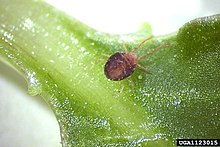
Mites are small arachnids. Mites span two large orders of arachnids, the Acariformes and the Parasitiformes, which were historically grouped together in the subclass Acari. However, most recent genetic analyses do not recover the two as each other's closest relative within Arachnida, rendering the group non-monophyletic. Most mites are tiny, less than 1 mm (0.04 in) in length, and have a simple, unsegmented body plan. The small size of most species makes them easily overlooked; some species live in water, many live in soil as decomposers, others live on plants, sometimes creating galls, while others again are predators or parasites. This last type includes the commercially destructive Varroa parasite of honey bees, as well as scabies mites of humans. Most species are harmless to humans, but a few are associated with allergies or may transmit diseases.

Tetranychus urticae is a species of plant-feeding mite generally considered to be a pest. It is the most widely known member of the family Tetranychidae or spider mites. Its genome was fully sequenced in 2011, and was the first genome sequence from any chelicerate.

Spider mites are members of the Tetranychidae family, which includes about 1,200 species. They are part of the subclass Acari (mites). Spider mites generally live on the undersides of leaves of plants, where they may spin protective silk webs, and can cause damage by puncturing the plant cells to feed. Spider mites are known to feed on several hundred species of plants.

The Acariformes, also known as the Actinotrichida, are the more diverse of the two superorders of mites. Over 32,000 described species are found in 351 families, with an estimated total of 440,000 to 929,000 species, including undescribed species.
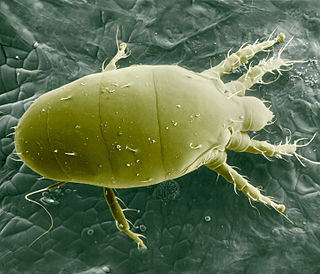
The broad mite, Polyphagotarsonemus latus, is a microscopic species of mite found on many species of plants, spanning 60 families including important agricultural species such as cotton, soybean, blackberries, strawberries, peppers, and other fruits. Broad mites are also currently affecting cannabis plants, as the industry matures with legalization. The mites are found in many areas worldwide and are major greenhouse pests.

Tarsonemus is a genus of trombidiform mites within the family Tarsonemidae.
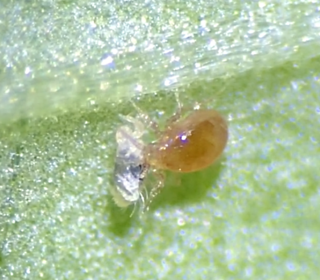
The Phytoseiidae are a family of mites which feed on thrips and other mite species. They are often used as a biological control agent for managing mite pests. Because of their usefulness as biological control agents, interest in Phytoseiidae has steadily increased over the past century. Public awareness of the biological control potential of invertebrates has been growing, though mainly in the US and Europe. In 1950, there were 34 known species. Today, there are 2,731 documented species organized in 90 genera and three subfamilies.
The Raphignathoidea is a superfamily of the Acari (mite) order Trombidiformes, comprising 1087 species in 62 genera and 12 families.
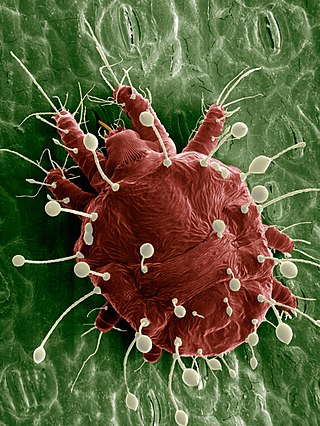
Raoiella indica, commonly known as the red palm mite, is a species of mite belonging to the family Tenuipalpidae. A pest of several species of palm in the Middle East and South East Asia, it is now becoming established throughout the Caribbean. The invasion of this species is the biggest mite explosion ever observed in the Americas.

Lorryia formosa, commonly known as the yellow mite or the citrus yellow mite, is a species of acariform mite. They are in the subfamily Tydeinae of the family Tydeidae. Commonly found on the foliage of citrus trees around the world, Lorryia formosa also associates with a variety of other plant types. The life cycle includes six discrete stages of development, and the lifespan averages about 37 days. The females of the species use an asexual form of reproduction where the growth and development of embryos occurs without fertilization by a male, a process called thelytoky.

Rhizoglyphus is a genus of mites in the family Acaridae. It has a worldwide distribution and is often associated with the bulbs, corms or tubers of plants.

Brevipalpus phoenicis, also known as the false spider mite, red and black flat mite, and in Australia as the passionvine mite, is a species of mite in the family Tenuipalpidae. This species occurs globally, and is a serious pest to such crops as citrus, tea, papaya, guava and coffee, and can heavily damage numerous other crops. They are unique in having haploid females, a condition caused by a bacterium that change haploid males into females.
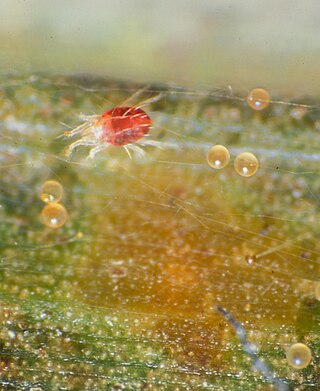
Oligonychus is a genus of mites in the family Tetranychidae, the spider mites. Many members of this genus are familiar pests of plants. There are about 200 described species.
Eriophyes tulipae, commonly known as the dry bulb mite, is a species of mite in the genus Eriophyes. This mite feeds on members of the lily family, and has damaged garlic crops. At one time, it was also thought to feed on wheat and other grasses, but the wheat curl mite is now regarded as a different species, Aceria tosichella.

Tetranychoidea is a superfamily of mites in the order Trombidiformes. There are about 5 families and more than 2,200 described species in Tetranychoidea.

Petrobia is a genus in Tetranychidae, containing 34 described species. It includes some pest species.
Magdalena Kathrina Petronella Smith Meyer was a South African acarologist who was regarded as a world authority on plant-feeding mites of agricultural importance and was known as the "mother of red-spider mites of the world". She described more than 700 new species and 25 new genera, mostly of mites of agricultural importance. Meyer was involved in the promotion of biological control of mites using predatory mites, spiders and insects.

Oligonychus pratensis, the Banks grass mite, is a species of mite in the spider mite family. They are considered a pest and often infest corn and turf grasses.

Bryobia graminum, also known as the clover mite, is a species of mite with a cosmopolitan distribution.
Aleuroglyphus ovatus, commonly known as brown-legged mite or brownlegged grain mite, is a species of mite in the family Acaridae. It is a cosmopolitan pest of grain.
